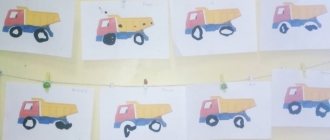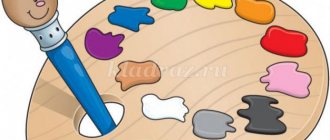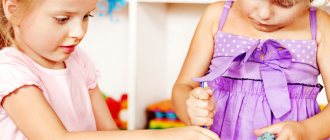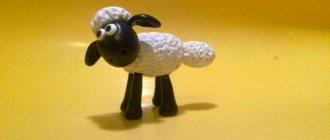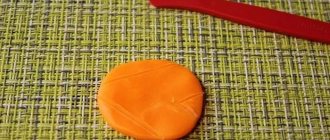Preview:
Educational field: Artistic and aesthetic development. Modeling.
Topic: "CATERPILLER"
Goal: strengthening technical skills and techniques for modeling dough. Sculpt from parts, divide a piece into parts, maintain the ratio of proportions in size, tightly connecting them. Develop fine motor skills. Develop creative imagination and coherent speech when composing a story about your craft.
Equipment: general composition - a panorama of summer, made using the technique of relief modeling, dough, stacks, flour, illustrations, a painting on the topic “Insects”, reproductions, poetry; music by P.I. Tchaikovsky “Seasons” “Summer”
Progress of the lesson
Organizing time
Greetings. Checking workplaces and equipment availability.
Today, guys, you will sculpt a caterpillar. Learn to divide a large piece of dough into equal parts.
Main part
The nature that surrounds us is beautiful and unique. How elegant are the flowers, fashionable butterflies, bright ladybugs. Such beauty can be drawn and sculpted.
Music is playing.
Look, guys, in what order you will work:
1) Divide a large piece of dough in half.
2) Divide each half into two more parts and roll into balls.
3) From the first part we make a head with eyes and a nose, pulling out the dough.
4) Connect all the parts.
We install all the tracks on the stand.
Physical education minute
One - rise, pull yourself up, Two - bend, unbend, Three - three claps of your hands, three nods of your head. Four - wider legs. Five - wave your hands, Six - sit quietly at the table.
Reflection.
The teacher offers to look at the children's work and write a story about their caterpillar.
A simple bird - modeling in the preparatory group
First, let's sculpt a simple bird out of plasticine. Roll a blue ball. We form the body in the shape of a droplet and bend the tail up. Connecting the head and body. We sculpt wings from two balls and use scissors to make 2 cuts on each. We also cut the tail. Add wings, beady eyes and yellow legs and beak. Creating such a bird is perfect for middle school children.
Summary of the modeling lesson “Spring Singers” for older children
Goal: - development of creative abilities and skills;
— enrich children’s knowledge on the topic: “Birds”;
- enrich knowledge of folklore.
Tasks.
Educational: - consolidation of modeling skills.
Developmental: - develop fine motor skills of the hand;
- development of attention when conveying the structure of birds (head, body, beak, wings, tail, paws).
Educational: - cultivate an emotionally positive attitude towards nature;
— cultivate a caring attitude and care for birds.
Materials and equipment: plasticine, modeling boards, stacks, music. player, photo material.
Teacher: - Hello, guys. Today, when I came to kindergarten, I saw a letter on the table (reading a letter).
“I came to visit you and drove away the frosts,
She ordered the sun to warm, the snow to melt, and the birds to sing.
But where are these birds?
Birds - birds - are small.
Help me, friends, fashion me a singer” (Suntsova Yu.V.).
Signed - Spring.
Teacher: - Guys, Spring is asking us for help. And who are these singers, do you understand?
Children: (answer options).
Teacher: - Yes, here they are these spring singers (shows photo material).
Does anyone know what these birds are called? Maybe you saw some of them on our site or in the park?
Children: (answer options).
Teacher: Let's get to know them better. Migratory birds appear here with the arrival of spring. Pay attention to the structure of the birds and their plumage colors. Each is unique in its own way and therefore recognizable among the people. What do you guys think, what are birds for in nature?
Children: (answer options).
Teacher: Let me add. There are many fairy tales associated with birds, signs: “Birds chirped merrily in the spring - to the thaw; bathing in dust or sand means rain.” The starling is the harbinger of spring. It is for this bird that we make birdhouses. For a long time, this bird was respected by peasants because the starling eats locusts, a pest of grain crops. The nightingale is an excellent singer, which is why the phrase “sing like a nightingale” has stuck. Sometimes birds are named for their character. Reel means “nimble, spinning.” Previously, in the old days, this was what they called lively young boys. According to one legend, the finch brought fire to humanity. The swallow is the messenger of spring, goodness, and home comfort. People consider it a good omen when a swallow settles under the roof of a house, and there are folk omens about it: “The swallow flies and invites warmth.”
Teacher: - Guys, there were also different figures in the letter, but I didn’t understand what they were for. Maybe Spring gave us a hint (lays out geometric shapes on a sheet of paper). Look, there is a big and a small circle, triangles of different sizes, trees and a drop. What is this?
Children: (answer options, brainstorming).
(Children assemble a bird from parts; finally, the teacher completes the eye.)
Teacher: Well done, guys, you guessed it. And April 1 is not only the day of laughter, but also the day of birds. Since ancient times, it has been believed that migratory birds bring spring on their wings. People were waiting for them, baking cookies in the shape of birds. They came up with barkers. Here is one of them:
(Finger gymnastics.)
“Birds, fly to us, bring the red sun, take away the winter.”
Teacher: Guys, we agreed to help Vesna, it’s time to get to work!
NOD - modeling (during modeling, the voices of birds and sounds of nature are heard).
Teacher: - Guys, look at what interesting singing birds we have created. Let's look at them. (The teacher, together with the children, notes interesting points, finds, modeling techniques, the children give names to their birds). Well done! I hope your birds brought spring.
And we will have warm weather... Goodbye.
